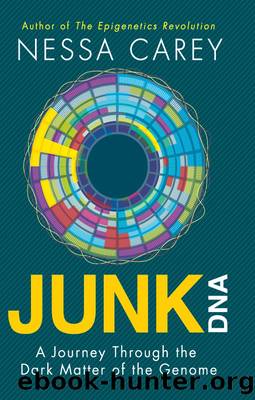Junk DNA by Carey Nessa

Author:Carey, Nessa
Language: eng
Format: epub
Publisher: Icon Books
Figure 12.4 The dots represent the positions of protein-coding genes in the nucleus. If genes were positioned in the nucleus solely as a function of their position on chromosomes, we would see a diffuse pattern such as the one on the left. Instead, genes cluster together in three-dimensional space, creating a punctate pattern of gene localisation represented by the situation on the right.
Each factory contains between four and 30 copies of the enzyme that makes a messenger RNA molecule from the DNA template, plus a large number of other molecules required to do the work.22,23 The enzymes stay in one place and the relevant gene is reeled through to be copied.24 In order for the gene to reach the factory, the DNA has to loop out to reach the right part of the cell nucleus. But the really ingenious bit is that more than one gene can be copied into messenger RNA at a time in the same factory. The combination of genes found in a single factory isn’t random. The genes tend to be ones that code for proteins that are used for related functions in the cell. This is equivalent to having multiple parallel assembly lines in one physical factory. Once all the lines have completed their individual tasks, the factory can assemble the final product from the components. One factory produces boats, another builds food mixers. In our cells, the factories ensure that genes are expressed in a coordinated fashion. This means lots of loops unfurling from chromosomes and localising to the same regions of the nucleus simultaneously.
One example of this is a factory for the genes that code for the proteins required to create the complex haemoglobin molecule, which carries oxygen around in the blood.25 Another factory is used to generate the proteins required in order to mount a strong immune response.26 One important component of an effective immune response is the production of proteins called antibodies. Antibodies circulate in the blood and other body fluids, binding to any foreign matter that they detect. Scientists activated the cells that produce antibodies and then studied how certain key genes looped out. The genes they analysed were the ones required to create antibody molecules. They found that these key genes moved to the same factory as each other. Remarkably, some of these genes were completely physically separate from each other normally, as they are located on different chromosomes.
Although this is a remarkable way of coordinating gene expression, it may also carry risks. Burkitt’s lymphoma is the aggressive cancer we met earlier in this chapter. The cell type that becomes abnormal in this disease is the cell type that produces antibodies. In this condition, a strong promoter from one chromosome gets abnormally positioned next to a gene from another chromosome. Until recently we didn’t understand why these regions were susceptible to joining up, because we thought of them as being physically distant from each other, as they are on different chromosomes. But now we know that the regions that
Download
This site does not store any files on its server. We only index and link to content provided by other sites. Please contact the content providers to delete copyright contents if any and email us, we'll remove relevant links or contents immediately.
| Cell Biology | Developmental Biology |
| Entomology | Marine Biology |
| Microbiology | Molecular Biology |
| Biostatistics |
Sapiens: A Brief History of Humankind by Yuval Noah Harari(13036)
The Tidewater Tales by John Barth(12025)
Do No Harm Stories of Life, Death and Brain Surgery by Henry Marsh(6332)
Mastermind: How to Think Like Sherlock Holmes by Maria Konnikova(6223)
The Thirst by Nesbo Jo(5777)
Why We Sleep: Unlocking the Power of Sleep and Dreams by Matthew Walker(5636)
Sapiens by Yuval Noah Harari(4528)
Life 3.0: Being Human in the Age of Artificial Intelligence by Tegmark Max(4492)
The Longevity Diet by Valter Longo(4441)
The Rules Do Not Apply by Ariel Levy(3897)
The Immortal Life of Henrietta Lacks by Rebecca Skloot(3819)
The Body: A Guide for Occupants by Bill Bryson(3788)
Why We Sleep by Matthew Walker(3767)
Animal Frequency by Melissa Alvarez(3749)
Yoga Anatomy by Kaminoff Leslie(3696)
Barron's AP Biology by Goldberg M.S. Deborah T(3627)
The Hacking of the American Mind by Robert H. Lustig(3575)
All Creatures Great and Small by James Herriot(3506)
Yoga Anatomy by Leslie Kaminoff & Amy Matthews(3392)
